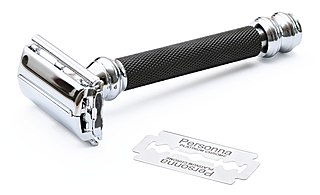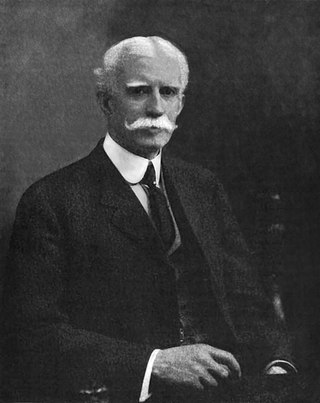
Shaving is the removal of hair, by using a razor or any other kind of bladed implement, to slice it down—to the level of the skin or otherwise. Shaving is most commonly practiced by men to remove their facial hair and by women to remove their leg and underarm hair. A man is called clean-shaven if he has had his beard entirely removed.

King Camp Gillette was an American businessman who invented a bestselling safety razor. Gillette's innovation was the thin, inexpensive, disposable blade of stamped steel. Gillette is often erroneously credited with inventing the so-called razor and blades business model in which razors are sold cheaply to increase the market for blades. However, Gillette Safety Razor Company adopted the business model from its competitors.

A pencil sharpener is a tool for sharpening a pencil's writing point by shaving away its worn surface. Pencil sharpeners may be operated manually or by an electric motor. It is common for many sharpeners to have a casing around them, which can be removed for emptying the pencil shavings debris into a bin.

A razor is a bladed tool primarily used in the removal of body hair through the act of shaving. Kinds of razors include straight razors, safety razors, disposable razors, and electric razors.

A safety razor is a shaving implement with a protective device positioned between the edge of the blade and the skin. The initial purpose of these protective devices was to reduce the level of skill needed for injury-free shaving, thereby reducing the reliance on professional barbers.
Gillette is an American brand of safety razors and other personal care products including shaving supplies, owned by the multi-national corporation Procter & Gamble (P&G). Based in Boston, Massachusetts, United States, it was owned by The Gillette Company, a supplier of products under various brands until that company merged into P&G in 2005. The Gillette Company was founded by King C. Gillette in 1901 as a safety razor manufacturer.
Dremel is a multinational brand of power tools, focusing on home improvement and hobby applications. Dremel is known primarily for its rotary tools, such as the Dremel 3000, 4000 and 8200 series, which are similar to the pneumatic die grinders used in the metalworking industry by tool or moldmakers. Dremel later expanded its product range and now produces butane tools, benchtop and hand-held saws and oscillating tools. The company was purchased by Robert Bosch GmbH in 1993, and is now a division of the Robert Bosch Tool Corporation.

An electric shaver is a razor with an electrically powered rotating or oscillating blade. The electric shaver usually does not require the use of shaving cream, soap, or water. The razor may be powered by a small DC motor, which is either powered by batteries or mains electricity. Many modern ones are powered using rechargeable batteries. Alternatively, an electro-mechanical oscillator driven by an AC-energized solenoid may be used. Some very early mechanical shavers had no electric motor and had to be powered by hand, for example by pulling a cord to drive a flywheel.

Wilkinson Sword is a formerly British brand for razors and other personal care products sold in Europe, owned by the US company Edgewell Personal Care. The company was founded as a manufacturer of guns made in Shotley Bridge in County Durham, by Henry Nock in London in 1772.

A straight razor is a razor with a blade that can fold into its handle. They are also called open razors and cut-throat razors. The predecessors of the modern straight razors include bronze razors, with cutting edges and fixed handles, produced by craftsmen from Ancient Egypt during the New Kingdom. Solid gold and copper razors were also found in Ancient Egyptian tombs dating back to the 4th millennium BC.

William Samuel Henson was a British-born pre-Wright brothers aviation pioneer, engineer and inventor. He is best known for his work on the aerial steam carriage alongside John Stringfellow.

DOVO Solingen, DOVO Steelware, or simply DOVO, is an independent German company, based in Solingen. They are a manufacturer of scissors, shaving equipment such as straight razors and safety razors, as well as manicure tools. DOVO was founded in 1906. The name derives from the last names of the original founders Carl Dorp + Carl Arthur Voos. Starting from 1950s onwards, DOVO has acquired multiple companies such as Tennis (1952), Bismarck (1957), "Ankerflagge" (1957), "Teufelskerle" (1968). "Kronpunkt" (1969), Fontana (1970), Heups & Hermes company (1973)
John Bloom was a British entrepreneur, best known for his role in the "Washing Machine Wars" of 1962–64 when he drastically reduced prices by direct sales that cut out the retailers. His company Rolls Razor made great inroads into the market but several manufacturers obtained injunctions to stop them selling at below the fixed retail price. His operation was also hit by a long postal strike and the withdrawal of a major backer, forcing the company into liquidation. Bloom was a controversial figure whose aggressive techniques shook up a complacent market but who gave new power to the consumer. His often-repeated motto "it's no sin to make a profit" became the title of his memoirs.

Barclays Bank Ltd v Quistclose Investments Ltd[1968] UKHL 4 is a leading property, unjust enrichment and trusts case, which invented a new species of proprietary interest in English law. A "Quistclose trust" arises when an asset is given to somebody for a specific purpose and if, for whatever reason, the purpose for the transfer fails, the transferor may take back the asset.

Henry Jacques ("Jack") Gaisman was an American philanthropist and inventor of a type of safety razor, the autographic camera, and over one thousand other patents which benefited common items such as swivel chairs, men's belts and carburetors.
Richard Reader Harris was a British Conservative Party politician. He was member of parliament for Heston and Isleworth from 1950 until 1970.
Safestyle UK plc, part of the Style Group UK, was a provider of PVCu double glazed windows, doors, French doors, patio sliding doors, bifolding doors and conservatories in the United Kingdom.

Thiers Issard or Thiers Issard Sabatier is a French cutlery manufacturer; they are one of a number of companies using the Sabatier name. It exports a wide range of knives and straight razors to approximately thirty countries. They are viewed as one of the top cutlery firms in Europe.
Colston was a British electrical appliance manufacturer, founded by ex-Hoover director Sir Charles Colston in 1955, that made compact dishwashers.

William Emery Nickerson was an American engineer and inventor. He worked with King C. Gillette at the start of the Gillette Company and was later elected to Gillette's board of directors. Nickerson has been called "the mechanical genius behind the safety razor," and received patents for hardening and sharpening the blades.















